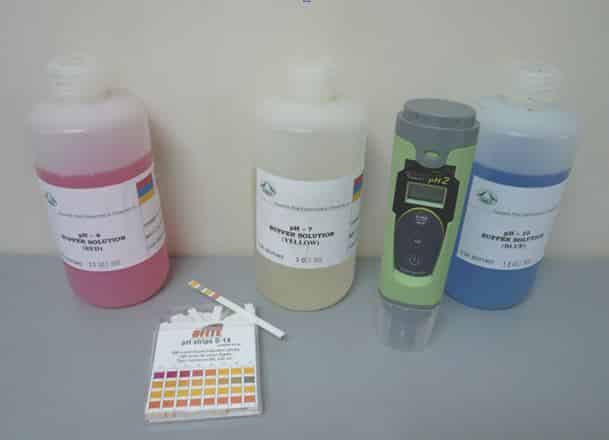pH In drilling mud is one of the major mud properties for monitoring as it had an effect on clay interactions, corrosion processes and solubility of certain chemicals. Drilling Mud pH can be measured using pH Strips or a pH Meter, as follows. According to above, we will present the steps of PH in drilling mud testing procedures.

Using PH Strips For PH in Drilling Mud Testing Procedures
PH Strips contain a row of pH-sensitive indicators that change color according to the pH of the fluid. The pH is determined by matching the color changes on the pH stick with the color chart supplied with the pH sticks. They are easy and convenient to use, with accuracy to the nearest 0.5 pH, although the interpretation of colors on the pH strips may be difficult if the fluid is discolored by additives in the fluid. High chloride concentrations above 10,000 ppm can also affect the accuracy of the results. The pH strips can only be used once and must then be thrown away.
The procedure for using pH strips in drilling fluid test is as follows:
- Place the pH strip face down on a sample of fluid or filtrate (i.e. colored indication squares in contact with the fluid), and leave for several seconds until no further color changes are observed on the pH strip.
- Shake off excess fluid. Match the color changes on the pH strip with the color chart supplied with the pH strips box, to determine the pH of the fluid to the nearest 0.5 pH.
Using pH Meters For pH in Drilling Mud Testing Procedures
pH Meters are much more accurate than pH strips, as long as regular checks are made to ensure that they are calibrated correctly. The device has a glass electrode probe that measures the hydrogen ion
concentration of the fluid. A range of pH meters is available, with operating instructions varying according to each model. However, the general procedure for using glass electrode pH meters involves calibrating the pH meter, measuring the pH of the sample, and finally cleaning and storing the probe, as follows:
- Remove the end cap, rinse the probe with distilled water, and blot dry.
- Wait until the sample is at the same temperature as the calibration buffer solution and the probe, preferably 70-80°F (20-28°C).
- Measure the temperature of the pH seven buffer solution.
- Place the probe in the pH seven buffer solution, switch on the pH meter, and wait for the digital reading to stabilize.
- Adjust the temperature knob on the pH meter to the temperature of the pH seven buffer solution and adjust the calibration knob to display the temperature-corrected pH (The buffer bottle will list the correct pH value for various temperatures). Once this is done, rinse the electrode with distilled water and blot dry.
- Repeat Steps 3, 4, and 5 using either pH four or pH ten buffer solution, choosing the buffer closest to the sample pH (usually pH 10 for muds). If the pH meter does not display the correct buffer pH value, adjust the calibration knob to obtain the correct pH reading. Rinse the electrode with distilled water and blot dry.
- Place the probe back in the pH seven buffer solution and re-check the pH. If the displayed pH value is different from that previously read in Step 5, use the slope adjustment screw located at the back of the pH meter to set the correct pH reading.
- Repeat Step 7 using either pH four or pH ten buffer solution, adjusting the slope adjustment screw until the pH meter reads the correct buffer value.
- After calibrating the pH meter using two buffer solutions, rinse the probe and blot dry before placing it in the sample.
- Stir gently and allow the digital reading to stabilize, recording the sample pH to the nearest 0.1 and the sample temperature in °F or °C.
- Unplug the meter and clean the probe with distilled water. Saturate the cotton in the end cap with pH 4 buffer and place the cap on the pH probe.
pH meters should be checked at regular intervals and re-calibrated in accordance with the instructions supplied with the model in use whenever necessary. The glass electrode should be cleaned occasionally with mild detergent and a soft brush to prevent the porous surface of the glass electrode from getting plugged with fine solids. Note that the pH of the filtrate may be different to the pH of the mud.